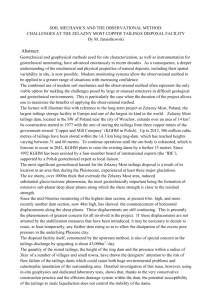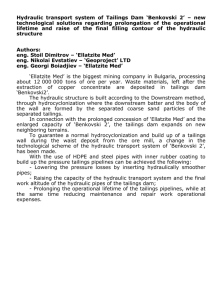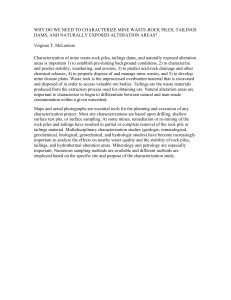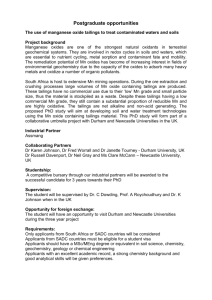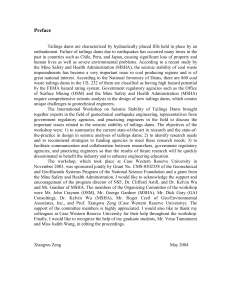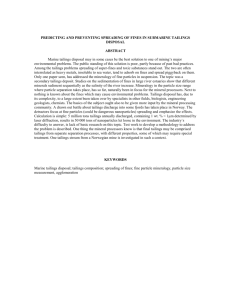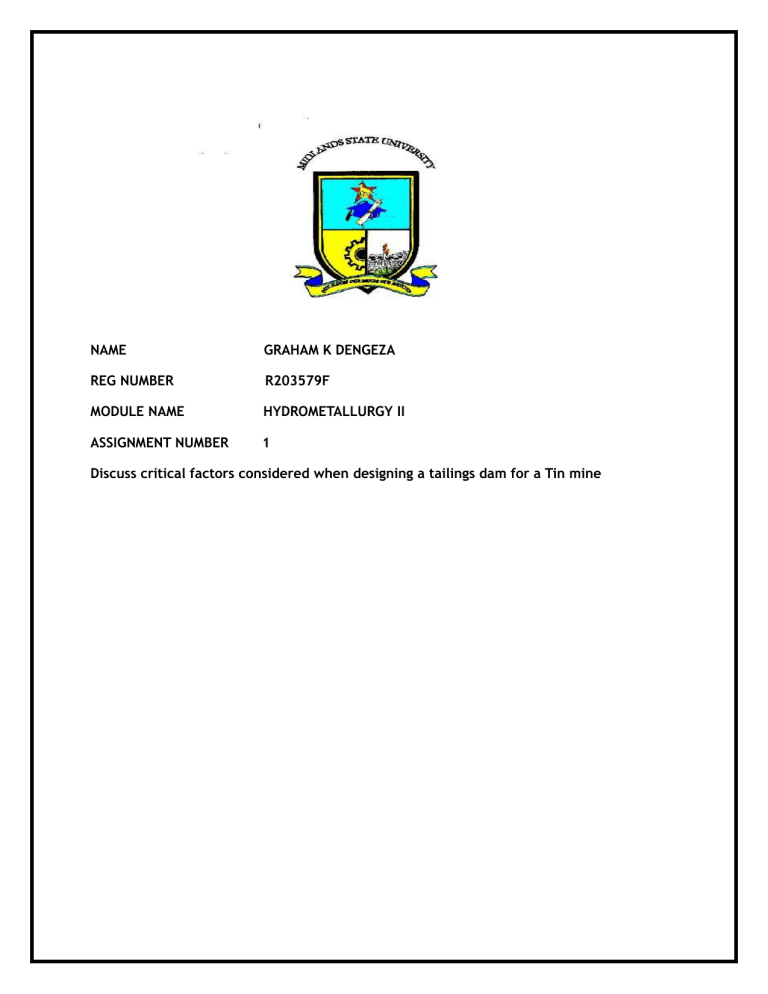
NAME GRAHAM K DENGEZA REG NUMBER R203579F MODULE NAME HYDROMETALLURGY II ASSIGNMENT NUMBER 1 Discuss critical factors considered when designing a tailings dam for a Tin mine Tailings dams are an important part of tin mining operations because they store waste materials generated during the extraction process. To ensure the safety and stability of a Tin tailings dam, several critical factors must be carefully considered for the design of the dams. The critical factors to consider include water management, environmental considerations, geotechnical consideration, maintenance and monitoring and construction materials. Water Management Water management is an important consideration in tailings dam design. Tin tailings dams are constructed to hold waste materials from mining operations, which frequently contain water. The amount of water in tin tailings varies depending on the type of ore mined and the processing methods used. As a result, effective water management is required to ensure the tailings dam's stability and safety. The amount of water that a tailings dam can store is determined by its design and construction. The dam's capacity must be adequate to handle the volume of water generated by the mining operation, including rainfall and runoff. To prevent water from accumulating and causing instability or failure, tailings dams must have effective drainage systems (Strachan and Goodwin, 2015). Spillways, seepage collection systems, and pumps are examples of drainage systems. Seepage is a major issue for tailings dams because it can cause erosion and instability. Liners or impermeable barriers may be installed within the dam structure to prevent seepage. Tailings dams may necessitate the installation of treatment systems to remove contaminants from the water before it is discharged into nearby streams or rivers. Environmental Considerations Tailings dams are structures that are used to store waste from mining operations. If not built and managed properly, these dams can pose significant environmental risks. As a result, environmental considerations are critical in the design and construction of tailings dams. The location of the tailings dam is critical for minimizing its environmental impact. The site should be chosen based on factors such as topography, geology, hydrology, and proximity to sensitive ecosystems (Edraki, et al., 2014). The design of the tailings dam should take into account the potential risks to the environment and nearby communities. The dam must be designed to withstand extreme weather events such as floods and earthquakes. During construction, measures must be taken to minimize the impact on the environment. For example, erosion control measures should be implemented to prevent sediment runoff into nearby waterways. Geotechnical considerations Geotechnical considerations play a crucial role in the design of tailings dams. Tailings dams are constructed to store waste materials from tin mining operations, and they must be designed to withstand the weight of the tailings, as well as any external forces that may act on them. The stability of the dam is a major geotechnical consideration in tailings dam design. The dam must be built to withstand sliding, overturning, and other modes of failure that could have disastrous consequences (Wei, et al., 2013). This necessitates a thorough examination of factors such as soil strength, slope stability, and seismic activity. Maintenance and monitoring Tailings dams are designed to store waste materials generated from mining operations. These dams are critical structures that require proper maintenance and monitoring to ensure their stability and safety. Proper maintenance of a tailings dam is essential to ensure its long-term stability. Maintenance activities such as vegetation control, erosion control, and regular inspections help prevent dam failure due to erosion or other factors. Regular monitoring of a tailings dam is necessary to detect any signs of instability or potential failure. Monitoring activities such as seepage measurements, slope stability analysis, and instrumentation installation help identify potential problems before they become critical (Martin and Davies, 2022). The results of maintenance and monitoring activities can influence the design of a tailings dam in several ways for example size, slope angle and drainage system Construction Material The construction material used in tailings dam design plays a crucial role in determining the stability and safety of the structure. The choice of material depends on various factors such as the type of tailings, site conditions, and environmental regulations (Vick, 2016). Some common materials used in tailings dam construction include Earth fill, Rock fill, Concrete, and Steel. The choice of construction material affects various aspects of tailings dam design, including: 1. Stability: The ability of a tailings dam to resist deformation and failure under various loading conditions determines its stability. The choice of construction material influences the structure's strength and stiffness, which determines its stability. 2. Seepage control: Tailings dams are designed to prevent seepage from contaminating nearby water sources. The choice of construction material affects the permeability of the structure, which determines its ability to control seepage. 3. Environmental impact: Tailings dams can have significant environmental impacts if they fail or leak contaminants into nearby water sources. The choice of construction material affects the potential for environmental damage in case of failure or leakage. Conclusion In conclusion tailings dam design necessitates careful consideration of a number of critical factors, including water management, environmental considerations, geotechnical consideration, and maintenance and monitoring and construction materials. Failure to take these factors into account can have disastrous consequences, such as environmental damage or loss of life. As a result, mining companies must prioritize safety when designing tailings dams in order to reduce the risks associated with their operations. REFERENCES Edraki, M., Baumgartl, T., Manlapig, E., Bradshaw, D., Franks, D.M. and Moran, C.J., 2014. Designing mine tailings for better environmental, social and economic outcomes: a review of alternative approaches. Journal of Cleaner Production, 84, pp.411-420. Martin, T.E. and Davies, M.P., 2022. Trends in the stewardship of tailings dams. In Tailings and Mine Waste 2000 (pp. 390-410). CRC Press. Oboni, F. and Oboni, C., 2020. Tailings dam management for the twenty-first century. Springer International Publishing. Strachan, C. and Goodwin, S., 2015. The role of water management in tailings dam incidents Szymanski, M.B. and Davies, M.P., 2004. Tailings dams: design criteria and safety evaluations at closure. Wei, Z., Yin, G., Wang, J.G., Wan, L. and Li, G., 2013. Design, construction and management of tailings storage facilities for surface disposal in China: case studies of failures. Waste Management & Research, 31(1), pp.106-112. Wei, Z., Yin, G., Wan, L. and Li, G., 2016. A case study on a geotechnical investigation of drainage methods for heightening a tailings dam. Environmental Earth Sciences, 75, pp.1-10. Vick, S.G., 2016. Planning, design, and analysis of tailings dams. BiTech Publishers Ltd. Edraki, M., Baumgartl, T., Manlapig, E., Bradshaw, D., Franks, D.M. and Moran, C.J., 2014. Designing mine tailings for better environmental, social and economic outcomes: a review of alternative approaches. Journal of Cleaner Production, 84, pp.411-420.
